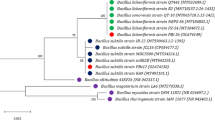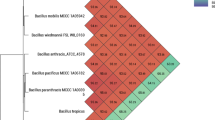Abstract
Organic agricultural practice using vermisources is considered as one of the common sustainable strategies in agriculture. Apart from their nutrient content, beneficial microbes associated with natural vermicast serve as an efficient bioinoculant for improving agricultural productivity. Hence, studies on the identification of suitable microbial inoculants with multi-trait plant beneficial properties from these hotspots are highly promising as an ecofriendly substitute against harmful chemical fertilizers. The current study has been designed to isolate bacterial strains with various plant probiotic and biocontrol properties against various fungal phytopathogens. Among the various bacteria obtained in the study, the isolate W11 was found to have remarkable inhibitory activity against a broad range of phytopathogens like Fusarium oxysporum, Pythium myriotylum, and Rhizoctonia solani, in addition to its multiple plant growth–promoting properties. The W11 was further identified as Bacillus sp. by 16S rDNA sequence-based analysis. The W11 treatment was also found to enhance the plant growth parameters of Vigna unguiculata. In addition, the priming of Bacillus sp. W11 on potato tuber has confirmed to protect it from Fusarium wilt caused by Fusarium oxysporum. This highlights the possible protective effect of W11 during the post-harvest storage of potatoes. Also, the metabolite analysis of W11 extract by LC–QTOF-MS/MS analysis has revealed the presence of lipopeptide surfactin derivatives with m/z of 1008, 1022, and 1036 (M + H)+. All the results obtained in the study thus indicate the remarkable agricultural promises of Bacillus sp. W11 isolated from vermicast. Even though vermicast has been studied for its beneficial agricultural applications, the isolation of plant beneficial bacteria from it and detailed characterization of its beneficial effects make the study important.


Similar content being viewed by others
Data Availability
All data generated or analyzed during this study are included in this article (and its supplementary information files).
References
Sivasankari, B., & Anandharaj, M. (2014). Isolation and molecular characterization of potential plant growth promoting Bacillus cereus GGBSTD1 and Pseudomonas spp. GGBSTD3 from vermisources. Advances in Agriculture, 2014, 13. https://doi.org/10.1155/2014/248591
Piya, S., Shrestha, I., Gauchan, D. P., Lamichhane. J. (2018). Vermicomposting in organic agriculture: Influence on the soil nutrients and plant growth. International Journal of Research 5(20): 1055–1063. https://pen2print.org/index.php/ijr/
Pathma, J., & Sakthivel, N. (2012). Microbial diversity of vermicompost bacteria that exhibit useful agricultural traits and waste management potential. Springer Plus, 1(1), 26. https://doi.org/10.1186/2193-1801-1-26
Vijayabharathi, R., Sathya, A., Gopalakrishnan, S. (2015). Plant growth-promoting microbes from herbal vermicompost. In: Egamberdieva D. Shrivastava S. Varma A. (eds) Plant-growth-promoting rhizobacteria (PGPR) and medicinal plants. Soil Biology vol 42. Springer Cham. https://doi.org/10.1007/978-3-319-13401-7_4
Aysha, O. S., Vinothkumar, P., Vasuki, S., Valli, S., Nirmala, P., & Reena, A. (2012). PGPR Bacillus species isolated from tomato plant–A comparative study on coconut water enrichment. International Journal of Bioassays, 1(11), 131–137.
Fu, S. F., Wei, J. Y., Chen, H. W., Liu, Y. Y., Lu, H. Y., & Chou, J. Y. (2015). Indole-3-acetic acid: A widespread physiological code in interactions of fungi with other organisms. Plant signaling & behavior, 10, 8. https://doi.org/10.1080/15592324.2015.1048052
Radhakrishnan, R., Hashem, A., & Abd Allah, E. F. (2017). Bacillus: A biological tool for crop improvement through bio-molecular changes in adverse environments. Frontiers in Physiology, 8, 667. https://doi.org/10.3389/fphys.2017.00667
Ongena, M., Jourdan, E., Adam, A., Paquot, M., Brans, A., Joris, B., Arpigny, J. L., & Thonart, P. (2007). Surfactin and fengycin lipopeptides of Bacillus subtilis as elicitors of induced systemic resistance in plants. Environmental Microbiology, 9(4), 1084–1090. https://doi.org/10.1111/j.1462-2920.2006.01202.x
Sarwar, A., Hassan, M. N., Imran, M., Iqbal, M., Majeed, S., Brader, G., & Hafeez, F. Y. (2018). Biocontrol activity of surfactin A purified from Bacillus NH-100 and NH-217 against rice bakanae disease. Microbiological Research, 209, 1–13. https://doi.org/10.1016/j.micres.2018.01.006
Widnyana, I. K., Kuspianta, I. W. S., & Sapanca, P. L. Y. (2018). Effect of seed soaking with Bacillus sp. and organic fertilizer on growth of mustard green (Brassica juncea L.). Asian Journal of Agriculture and Biology, 6(2), 204–209.
Intorne, A. C., de Oliveira, M. V. V., Lima, M. L., da Silva, J. F., Olivares, F. L., & de Souza Filho, G. A. (2009). Identification and characterization of Gluconacetobacter diazotrophicus mutants defective in the solubilization of phosphorus and zinc. Archives of Microbiology, 191(5), 477–483. https://doi.org/10.1007/s00203-009-0472-0
Dinesh, R., Anandaraj, M., Kumar, A., Bini, Y. K., Subila, K. P., & Aravind, R. (2015). Isolation characterization and evaluation of multi-trait plant growth promoting rhizobacteria for their growth promoting and disease suppressing effects on ginger. Microbiological Research, 173, 34–43. https://doi.org/10.1016/j.micres.2015.01.014
Jasim, B., Jimtha, C. J., Jyothis, M., & Krishnan, E. K. (2013). Plant growth promoting potential of endophytic bacteria isolated from Piper nigrum. Plant Growth Regul, 71(1), 1–11. https://doi.org/10.1007/s10725-013-9802-y
Radhakrishnan, N. A., Ravi, A., Joseph, B. J., Jose, A., Jithesh, O., Krishnankutty, R. E. (2021). Phenazine 1-carboxylic acid producing seed harbored endophytic bacteria from cultivated rice variety of kerala and its broad range antagonism to diverse plant pathogens. Probiotics and Antimicrobial Proteins 1-8. https://doi.org/10.1007/s12602-021-09844-x
Yoon, S. H., Ha, S. M., Kwon, S., Lim, J., Kim, Y., Seo, H., & Chun, J. (2017). Introducing EzBioCloud: A taxonomically united database of 16S rRNA gene sequences and whole-genome assemblies. International Journal of Systematic and Evolutionary Microbiology., 67(5), 1613. https://doi.org/10.1099/ijsem.0.001755
Chun, J., Oren, A., Ventosa, A., Christensen, H., Arahal, D. R., da Costa, M. S., Rooney, A. P., Yi, H., Xu, X. W., De Meyer, S., & Trujillo, M. E. (2018). Proposed minimal standards for the use of genome data for the taxonomy of prokaryotes. International journal of systematic and evolutionary microbiology., 68(1), 461–466. https://doi.org/10.1099/ijsem.0.002516
Sabu, R., Aswani, R., Jishma, P., Jasim, B., Mathew, J., & Radhakrishnan, E. K. (2019). Plant growth promoting endophytic Serratia sp. ZoB14 protecting ginger from fungal pathogens. Proceedings of the National Academy of Sciences, India Section B: Biological Sciences, 89(1), 213–220. https://doi.org/10.1007/s40011-017-0936-y
Kiriya, S., Boonthaiiwai, C., Wongcharoen, A., Promkhambut, A., & Lesueur, D. (2014). Potential of native phosphate solubilizing bacteria isolated from the rhizosphere of economic crops and vermicast in Northeast Thailand to solubilize insoluble phosphates under in vitro conditions. International Journal of Environmental and Rural Development, 5(2), 110–115. https://doi.org/10.32115/ijerd.5.2_110
Begum, M. C., Islam, M., Sarkar, M. R., Azad, M. A. S., Huda, A. N., & Kabir, A. H. (2016). Auxin signaling is closely associated with Zn-efficiency in rice (Oryza sativa L.). Journal of Plant Interactions, 11(1), 124–129. https://doi.org/10.1080/17429145.2016.1220026
Fallo, G., Mubarik, N. R. (2015). Potency of auxin producing and phosphate solubilizing bacteria from dry land in rice paddy field. Research Journal of Microbiology 10(6):246. http://scialert.net/fulltext/?doi=jm....
Mohamed, A. E., Nessim, M. G., Ibrahim Abou-el-seoud, I., Darwish, K. M., & Shamseldin, A. (2019). Isolation and selection of highly effective phosphate solubilizing bacterial strains to promote wheat growth in Egyptian calcareous soils. Bull Natl Res Cent, 43(1), 203. https://doi.org/10.1186/s42269-019-0212-9
Beibei, W. A., Zongzhuan, S. H., Zhang, F., Waseem, R. A., Jim, Y. U., Huang, R., Yunze, R. U., Rong, L. I., & Qirong, S. H. (2016). Bacillus amyloliquefaciens strain W19 can promote growth and yield and suppress Fusarium wilt in banana under greenhouse and field conditions. Pedosphere, 26(5), 733–744. https://doi.org/10.1016/S1002-0160(15)60083-2
Kamali, M., Ahmadi, J., Naeimi, S., & Guo, D. (2019). Characterization of Bacillus isolates from the rhizosphere of tomato suppressing Fusarium wilt disease. Acta Phytopathol Entomol Hung, 54(1), 53–68. https://doi.org/10.1556/038.54.2019.006
Wan, T., Zhao, H., & Wang, W. (2018). Effects of the biocontrol agent Bacillus amyloliquefaciens SN16-1 on the rhizosphere bacterial community and growth of tomato. Journal of Phytopathology, 166(5), 324–332. https://doi.org/10.1111/jph.12690
Shah, R., Amaresan, N., Patel, P., Jinal, H. N., & Krishnamurthy, R. (2020). Isolation and characterization of Bacillus spp. endowed with multifarious plant growth promoting traits and their potential effect on tomato (Lycopersicon esculentum) seedlings. Arabian Journal for Science and Engineering, 45, 4579–4587. https://doi.org/10.1007/s13369-020-04543-1
Li, Y., Héloir, M. C., Zhang, X., Geissler, M., Trouvelot, S., Jacquens, L., & Adrian, M. (2019). Surfactin and fengycin contribute to the protection of a Bacillus subtilis strain against grape downy mildew by both direct effect and defence stimulation. Molecular Plant Pathology, 20(8), 1037–1050. https://doi.org/10.1111/mpp.12809
Jasim, B., Sreelakshmi, K. S., Mathew, J., & Radhakrishnan, E. K. (2016). Surfactin, iturin, and fengycin biosynthesis by endophytic Bacillus sp. from Bacopa monnieri. Microbial Ecology, 72(1), 106–19. https://doi.org/10.1007/s00248-016-0753-5
Chen, Z., Wu, Q., Wang, L., Chen, S., Lin, L., Wang, H., & Xu, Y. (2020). Identification and quantification of surfactin a nonvolatile lipopeptide in Moutai liquor. International Journal of Food Properties, 23(1), 189–198. https://doi.org/10.1080/10942912.2020.1716791
Sudarmono, P., Wibisana, A., Listriyani, L. W., Sungkar, S. (2019). Characterization and synergistic anti-microbial evaluation of lipopeptides from Bacillus amyloliquefaciens isolated from oil-contaminated soil. International Journal of Microbiology 2019. https://doi.org/10.1155/2019/3704198
Płaza, G., Chojniak, J., Rudnicka, K., Paraszkiewicz, K., & Bernat, P. (2015). Detection of biosurfactants in Bacillus species: Genes and products identification. Journal of applied microbiology., 119(4), 1023–1034. https://doi.org/10.1111/jam.12893
Wu, S., Liu, G., Zhou, S., Sha, Z., & Sun, C. (2019). Characterization of antifungal lipopeptide biosurfactants produced by marine bacterium Bacillus sp. CS30. Marine Drugs, 17(4), 199. https://doi.org/10.3390/md17040199
Acknowledgements
We are highly thankful to Kerala State Plan Fund for research grant of a Project entitled “Exploring the Indigenous Microbiome of Kerala for Natural and Organic Agricultural Practices—an Approach to Green Kerala.” The authors also acknowledge KSCSTE-KBC-YIPB (673/2017/KSCSTE dated 13.10.2017). The authors acknowledge our sincere thanks to DST-SAIF & IIUCNN for the instrumental support. The Authors also acknowledge DST-PURSE P II Programme for the support.
Funding
Kerala State Plan Fund for research grant of the Project entitled “Exploring Indigenous Microbiome of Kerala for Natural and Organic Agricultural Practices—an Approach to Green Kerala” and KSCSTE-KBC-YIPB (673/2017/KSCSTE dated 13.10.2017).
Author information
Authors and Affiliations
Contributions
Conceptualization: Bicky Jerin Joseph, Amala Geevarghese, Nayana Aluparambil Radhakrishnan, and Radhakrishnan Edayileveettil Krishnankutty. Methodology: Bicky Jerin Joseph, Amala, and Radhakrishnan Edayileveettil Krishnankutty. Investigation: Aswani Ravi, Amala Geevarghese, Jithesh O, and Radhakrishnan Edayileveettil Krishnankutty. Formal analysis and data curation: Bicky Jerin Joseph, Amala Geevarghese, Aswani Ravi, and Radhakrishnan Edayileveettil Krishnankutty. Supervision: Jyothis Mathew, Jithesh O and Radhakrishnan Edayileveettil Krishnankutty. Writing, review and editing: Bicky Jerin Joseph, Aswani Ravi, Amala Geevarghese, Jithesh O, Jyothis Mathew and Radhakrishnan Edayileveettil Krishnankutty. Funding acquisition: Radhakrishnan Edayileveettil Krishnankutty.
Corresponding author
Ethics declarations
Ethical Approval
This is not applicable because this study does not involve human participants, cell lines, and antibodies.
Consent to Participate
This is not applicable because this study does not involve human participants.
Consent for Publication
This is not applicable because this study does not involve human participants.
Competing Interests
The authors declare no competing interests.
Additional information
Publisher's Note
Springer Nature remains neutral with regard to jurisdictional claims in published maps and institutional affiliations.
Supplementary Information
Below is the link to the electronic supplementary material.
Rights and permissions
Springer Nature or its licensor (e.g. a society or other partner) holds exclusive rights to this article under a publishing agreement with the author(s) or other rightsholder(s); author self-archiving of the accepted manuscript version of this article is solely governed by the terms of such publishing agreement and applicable law.
About this article
Cite this article
Joseph, B.J., Ravi, A., Geevarghese, A. et al. Multifarious Plant Probiotic Features of Bacillus sp. W11 Isolated from Vermicast and Its Promises for Biocontrol Activity Against Phytopathogens. Appl Biochem Biotechnol 195, 3615–3627 (2023). https://doi.org/10.1007/s12010-022-04285-w
Accepted:
Published:
Issue Date:
DOI: https://doi.org/10.1007/s12010-022-04285-w




